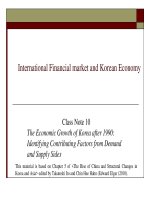Economic growth and economic development 19
Bạn đang xem bản rút gọn của tài liệu. Xem và tải ngay bản đầy đủ của tài liệu tại đây (48.14 KB, 1 trang )
.4
Introduction to Modern Economic Growth
1960
.3
2000
0
Density of coutries
.1
.2
1980
6
7
8
log gdp per capita
9
10
11
Figure 1.2. Estimates of the distribution of countries according to
log GDP per capita (PPP-adjusted) in 1960, 1980 and 2000.
that some of the middle-income countries of the 1960s have joined the ranks of
relatively high-income countries, while others have maintained their middle-income
status or even experienced relative impoverishment.
While Figures 1.1 and 1.2 show that there is somewhat greater inequality among
nations, an equally relevant concept might be inequality among individuals in the
world economy. Figures 1.1 and 1.2 are not directly informative on this, since they
treat each country identically irrespective of the size of their population. The alternative is presented in Figure 1.3, which shows the population-weighted distribution.
In this case, countries such as China, India, the United States and Russia receive
greater weight because they have larger populations. The picture that emerges in
this case is quite different. In fact, the 2000 distribution looks less spread-out, with
thinner left tail than the 1960 distribution. This reflects the fact that in 1960 China
and India were among the poorest nations, whereas their relatively rapid growth in
5









